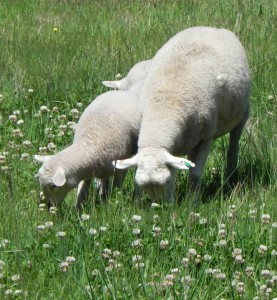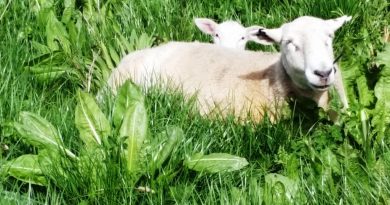Moffitts Farm livestock enterprises

Moffitts Farm livestock enterprises are maintained to utilise the prolific, year-round-green perennial pastures (based on introduced species including cocksfoot, tall fescue, perennial ryegrass, phalaris, white clover, chicory, plantain) which are the principle focus of holistic grazing management. Rainfall in the district is spread throughout the year with 30% occurring in summer months. This means pasture growth can be maintained throughout the year with peak growth occurring from August to December.
Wiltipoll self-replacing flock
The Wiltipoll flock enterprise was started in 2012. It is intended to grow the ewe number to around 100 animals lambing each spring. Progeny will be sold for meat direct to abattoirs, as well as some wethers being sold to local small landholders for low maintenance pasture management. Moffitts Farm Wiltipoll meat can be purchased from Meatsmith in Fitzroy, Melbourne, Victoria.
Wiltipolls were chosen from amongst other sheep breeds because we were looking for a low maintenance sheep breed which does not require shearing, crutching or fly strike avoidance treatment; which has high fecundity (ability to produce multiple births); which sheds 100% of its wool each year; has a genetic maturity pattern which allows meat animals to be processed at a wide range of carcase weights – from domestic trade around 20 – 22 kg to export at 28 – 30 kg; and which is docile and intelligent to learn to move regularly from paddock to paddock under holistic grazing without mustering.

For no shearing or wool shedding sheep the alternative is Dorpers. These are developing a growing following in remote pastoral stations as an alternative to Merinos. Where shearing cost, maintenance of shearing team quarters, difficulty in attracting shearing staff due to remote areas, and low fecundity has put Merino sheep at a disadvantage, the Dorper is a viable alternative for sheep meat production. Two aspects of the Dorper I was not attracted to were the tendency for individuals to hold onto wool on the back – often called a ‘rug’. This could easily be a focus for fly strike during early summer thunderstorms commonly experienced in the Romsey district. Secondly, many of the pure breds I inspected were early maturity animals, that is, reached maturity at relatively low live weights. This is a genetic trait which suits the highly variable nutrition available on pastoral stations. A feature of the Dorpers I saw on stations was their ability to have excellent lambing rates and for the lambs to grow rapidly on seemingly low pasture quality. At Moffitts Farm pasture is abundant year round so we need animals with genetic potential to take advantage of this.
Our approach with holistic grazing is stocking flexibility to maximise pasture growth, ground cover and soil health irrespective of rainfall. There is a significant advantage in stocking the farm with livestock that have potential to grow to heavier weights rather than reaching maturity at lighter weights then laying down fat when production pasture is still available. This allows us to take advantage of the year-round-green pastures particularly during summer. We prefer to keep an animal growing to a higher sale live weight than running a higher proportion of breeding animals.
The Wiltipolls were sourced from Greg and John Toll at Gee Tee Stud Gunbower, Victoria. The Tolls sheep impressed for two main reasons, they were particularly docile in the paddock and they were 100% shedders by end of spring. Another attribute was the commercial focus the Tolls displayed to their sheep. They have been breeding Wiltshire Horns since the 1970’s and then moved to Wiltipolls. While being a sheep stud, the Tolls are commercial farmers growing irrigated lucerne hay and supplying the local Gunbower Abattoir with approximately 80% of its annual lamb requirements. The Wiltipoll carcases inspected in the butcher shop demonstrated the Tee Dee’s animal’s ability to reach a range of carcase weights up to 29 kg without excessive fat. This is the genetic potential we are looking for in sheep.
When the Wiltipoll ewes arrived on Moffitts Farm we gave them a two week ‘induction’ to teach them to follow a person into a new paddock. It is a process used by many pastoral cattle producers to quieten and teach weaner cattle to walk with stockman, one leading on horseback and other following. Each day the ewes were moved from the paddock into the sheep yards where high palatability pellets were given out in simple feeders. After half an hour or so the ewes were ‘called’ out of the yards. Repeating the process every day for two weeks meant the ewes became used to be called into and out of the yards with a feed reward for coming in. This process will not be required again for sheep born on Moffitts Farm as lambs are learning the process from their mothers. Ewes with lambs (over five days old) move with calling to their new paddock just as well as dry ewes.
Fencing
For holistic grazing cattle on Moffitts Farm existing paddocks have been subdivided with a single electric wire. This is not enough for sheep and two more plain wires were added to subdivision fences. With the middle wire hot and the other two as earths sheep have stayed in their paddock. When cattle are grazing in front of the sheep only the top wire is ‘hot’. With holistic grazing livestock pressure on fences is minimised as there is plenty of pasture in the paddock being grazed, usually starting at around 4000 kg green dry matter per hectare with the animals moved on in 5 to 8 days before feed quantity drops below 2000 kg green dry matter per hectare.
ANGUS CATTLE
The cattle enterprise on Moffitts Farm has been based on trade Angus cattle since 2000. This has enabled full flexibility to match pasture quantity to carry capacity and if necessary destock. The 13 year period up to 2009 was the driest run of years experienced in south eastern Australia.
A range of purchases have been made, cows with calves at foot and to calve, heifers and steers. Since 2005 we purchased steers from my brother, starting with two age groups – weaners around 280 kg live weight and yearlings around 400 kg live weight. This is done to compliment pasture growth and availability. The yearlings will grow out to sell weight above 600 kg by January or February (after 8 months). After they are sold, only the lighter weight animals (now yearlings) are retained on the farm during autumn and winter – which up to 2009 were receiving 30% less rainfall than prior to 1997. By the next June/July a decision is made on purchasing a new group of steers based on current pasture availability and climate outlook associated with the Southern Oscillation Index and the Indian Ocean Dipole.

In 2012 with the introduction of a self- replacing Wiltipoll flock the steer purchasing strategy changed. The sheep have become the “background” livestock (replacing the weaners) while the yearling steers are the “flexible” stock to be kept on to the heaviest weights achievable based on pasture availability in summer and the requirement for a bank of feed in autumn and winter.
Steers suit our holistic grazing system better than heifers because of their genetic potential to continue growing to heavier weights without laying down excess fat. With good summer rain as experienced in 2010/11 and 2011/12 the steers were retained until March as “growth” feed was excessive and they reached 650 – 720 kg live weight. Heifers on the other hand would have to be sold at lighter weights and more animals purchased with the risk of not finishing them that summer.
Trade cattle have been demonstrated in the Holmes Sackett benchmarking survey to be the most profitable cattle enterprise over many years. Our experience is that once purchased these animals are extremely cost effective as under holistic grazing there are no added costs associated with animal health treatments or veterinary care.
An important component of a profitable trading enterprise is buying at a similar price to what the animals sell for. For this reason we avoid special weaner sales and prefer to purchase animals around 380 – 420 kg direct from a local breeder using the Eastern Yearling Cattle Indicator to set the price. This gives both seller and buying a solid base on which to agree on a price and the vendor avoids expensive selling and transport costs. Stress on the animals is minimised.
We have found purchased cattle quickly adjust to the regular moving between paddocks and within three weeks learn to take themselves between paddocks after being ‘called’, therefore avoiding mustering.




